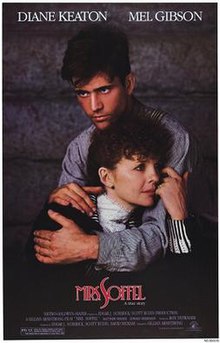Mrs. Soffel
| Mrs. Soffel | |
|---|---|
 Promotional movie poster for the film | |
| Directed by | Gillian Armstrong |
| Written by | Ron Nyswaner |
| Produced by | Edgar J. Scherick David A. Nicksay Scott Rudin |
| Starring | |
| Cinematography | Russell Boyd |
| Edited by | Nicholas Beauman |
| Music by | Mark Isham |
Production company | |
| Distributed by | MGM/UA Entertainment Company |
Release date |
|
Running time | 112 minutes |
| Country | United States |
| Language | English |
| Budget | $11 million[1] |
| Box office | $4,385,312 |
Mrs. Soffel is a 1984 American drama film directed by Gillian Armstrong, starring Diane Keaton and Mel Gibson and based on the story of condemned brothers Jack and Ed Biddle, who escaped prison with the aid of Kate Soffel, the warden's wife.
It was filmed on location in and around the Serez family farm in Mulmur, Ontario, as well as Wisconsin (train sequences) and establishing shots in Pittsburgh. The jail sequences were filmed in both the Allegheny County Courthouse and inside and outside of the old Allegheny County Jail for three days, and prisoners there were used as extras in the movie. The film was entered in the 35th Berlin International Film Festival.[2]
Plot
[edit]Kate Soffel is the wife of a Pittsburgh prison warden in 1901. They have four children. After several months of being sick in bed for no discernible reason, she suddenly regains her strength. She visits inmates to read Bible scripture to them and meets Ed Biddle and his brother Jack, both of whom may be innocent of the crimes that brought them there. Mrs. Soffel falls in love with Ed and enables him and Jack to escape, smuggling bar-cutting blades to them at the prison. They go on the run together, with tragic results.
Cast
[edit]- Diane Keaton as Kate Soffel
- Mel Gibson as Ed Biddle
- Matthew Modine as Jack Biddle
- Edward Herrmann as Warden Peter Soffel
- Trini Alvarado as Irene Soffel
- Jennifer Dundas as Margaret Soffel
- Danny Corkill as Eddie Soffel
- Harley Cross as Clarence Soffel
- Terry O'Quinn as Detective Charles "Buck" McGovern
- Pippa Pearthree as Maggie
- William Youmans as Guard George Koslow
- Maury Chaykin as Guard Charlie Reynolds
- Joyce Ebert as Matron Agnes Garvey
- Wayne Robson as Halliday
- Dana Wheeler-Nicholson as Jessie Bodyne
- Les Rubie as Mr. Stevenson
- Paula Trueman as Mrs. Stevenson
- Katie McCombs as Rachel Garvey
- William Duell as Lenny
- Walter Massey as Mr. Robinson
Reception
[edit]Pauline Kael wrote:
What's daring in the way Gillian Armstrong presents this love story is that we don't quite trust the emotions of either Kate Soffel or Ed Biddle. She's sickly, frustrated, unstable; he's an opportunist, with only one opportunity-- to make her love him so madly that she'll bring him and Jack the saws they need to get out...Mel Gibson...is superb here. Much wirier than in his earlier roles, he's convincingly passionate, shrewd, relentless...Diane Keaton has trouble with the period role...But she has a moment here that's freakishly inspired: Ed has been holding her against the bars and she's been speaking like a moral exemplar when suddenly, in mid-sentence, she lets out a dirty little giggle. We know then that Kate is living in a fever dream and doesn't want to wake up. And the post-hippie diction and the other surface flaws in Keaton's performance fade into relative insignificance, because the things that come from inside are so startlingly right...The movie builds an excitement that has something to do with the fact that the flight of the Biddles with Kate in tow is deranged. They're killing each other by staying together, but you can see that staying together is all that matters to them.[3][4]
On Rotten Tomatoes, it has a 46% approval rating based on 13 reviews, with an average score of 5.1/10. Roger Ebert gave the film two stars, calling it "an anemic Bonnie and Clyde" and concluded that the performances were unconvincing.[5][6] Vincent Canby called it a "very strange and maddening movie", but praised the performances of Keaton and Gibson.[7]
References
[edit]- ^ "AFI|Catalog".
- ^ "Berlinale: 1985 Programme". berlinale.de. Retrieved 2011-01-09.
- ^ Kael, Pauline (January 7, 1985). "Fever Dream". The New Yorker.
- ^ Kael, Pauline. Taking It All In. pp. 290–93.
- ^ Roger Ebert (1984-01-01). "Mrs. Soffel Movie Review". rogerebert.com. Retrieved 2017-06-17.
- ^ Mrs. Soffel (1984) Roger Ebert Movie Review - The Official Roger Ebert on YouTube
- ^ Vincent Canby (1984-12-26). "Movie Review -- Diane Keaton Portrays 'Mrs. Soffel'". The New York Times. Retrieved 2017-06-17.
External links
[edit]- 1984 films
- 1984 drama films
- 1980s prison films
- Romantic period films
- Films set in Pittsburgh
- Films directed by Gillian Armstrong
- Films with screenplays by Ron Nyswaner
- American films based on actual events
- American prison drama films
- Metro-Goldwyn-Mayer films
- Films produced by Scott Rudin
- Films scored by Mark Isham
- 1980s English-language films
- 1980s American films
- English-language crime films
- Films set in 1901
- Films set in the 1900s
